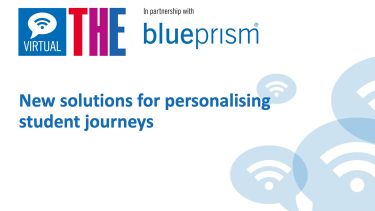By using smart software to automate tasks, universities can increase efficiency while making savings
Intelligent automation can transform the way universities deliver services, potentially saving millions of pounds in resources and recovering thousands of hours spent on administration.
As part of Digital Universities Week, a Times Higher Education session hosted in partnership with Blueprism explored how intelligent automation software could aid institutions in their digital transformation.
Jonny Bartrum, public sector account developer at Blueprism, said integrating the technology would free up resources for staff, empowering them to better deliver services and ultimately enhance the student experience.
“If you look at a university, one of the biggest challenges we see is the inefficiency of manual processes,” Bartrum said.
Many processes were performed by administrative and professional staff, for example in finance, HR and student services, leading to an “inflexible deployment of resources”.
“You’re not using your employees to the best of their capabilities, you’re actually having them do these administrative tasks that are usually high volume, repetitive and really simple,” said Bartrum. “We want to remove that, and we refer to it as removing the robot from the human. It’s allowing the humans to do the human work, which is that collaboration and being creative.”
A key goal of intelligent automation is to increase efficiency and productivity. Using “digital workers”, institutions can remove or reduce the administrative burden for an employee, their team or department.
In doing so, universities can empower their workforce to spend more time on human tasks, including providing high-quality student services, Bartrum said.
Using the “unlimited resource” of intelligent automation could speed up mundane tasks and be scaled to deal with peaks in demand during the year, for example, student admissions.
“A prime example for anyone in the finance world is invoice processing,” said Bartrum. “Every organisation has a basic level of automation. What we’re trying to do is come in as a layer over the top of the whole organisation to deliver what we’d call a digital workforce.”
Examples of where this technology has freed up university staff include University College London, which has saved more than £200,000 by automating just four processes. The University of Plymouth has returned 5,000 hours to the organisation every year through automation and Staffordshire University moved to automate some processes after a survey found that staff felt burdened with admin.
The University of Sydney automated more than 100 processes across the university, from admissions to back-office functions and exam checks, 90 per cent of which are now automated. This delivers the institution annual savings of £2.4 million.
These real-world examples show just how beneficial automation can be to universities, enabling staff to deliver the best experience to students.
Watch the session on demand above or on the THE Connect YouTube channel.
Find out more about Blue Prism.

